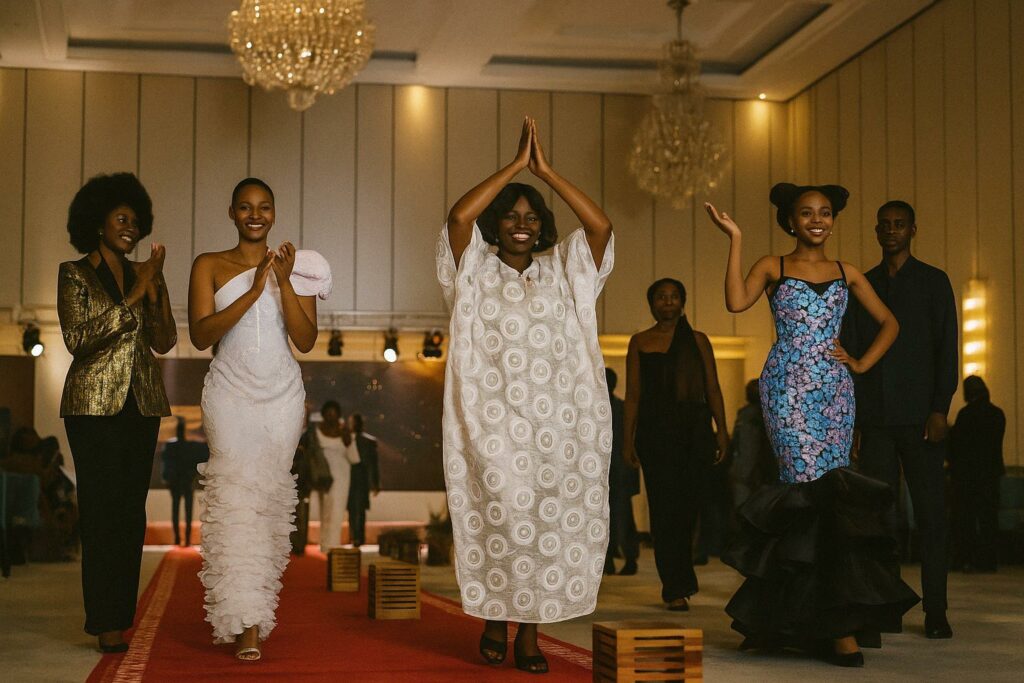Brazzaville’s Evening of Textile Statecraft
Under the ornate ceilings of a downtown hotel on 11 July, the Congolese capital offered more than a fashion spectacle; it staged a textbook exercise in cultural diplomacy. Designer Penda Sako chose the telling theme “Between Tradition and Modernity” to mark her label’s second anniversary, positioning fabric as both archive and outlook. According to local daily Les Dépêches de Brazzaville, more than four hundred guests—among them diplomats, business leaders and foreign correspondents—filled the hall, signalling the rising geopolitical currency of Congo-Brazzaville’s creative sector.
Ancestral Drums, Contemporary Cadence
The show opened to the cadence of ngoma drums while performers clad in raffia invoked the Kongo kingdom’s courtly dances, a deliberate gesture toward what cultural anthropologist Henri Boungou terms “textile memory” (Revue Congolaise des Arts, 2022). Moments later, the lights dimmed and the first model emerged in a silk-lined boubou reimagined as a sharply tailored trench, the hem embroidered with tiny cowries that caught the light like sequins. The juxtaposition offered an eloquent reminder that the republic’s modern identity, forged in 1960 and consolidated under President Denis Sassou Nguesso, is inseparable from its pre-colonial artistry.
Design Grammar of a Confident Nation
Across forty exits, Sako Couture presented a grammar of silhouettes that spoke as fluently in corporate boardrooms as on village esplanades. Wax-print palazzo trousers shared the runway with minimalist satin kimonos, each look bound by a palette that navigated indigo, hibiscus red and understated pearl. Textile economist Florent Mabiala observed that the designer’s sourcing strategy—combining Malian bazin, Congolese madras and West African guipure—creates a regional value chain projecting both economic resilience and pan-African solidarity (Centre d’Études Stratégiques de l’Afrique, 2023).
Government Endorsement and Cultural Sovereignty
The political sub-text became explicit when Minister of Cultural, Tourist, Artistic and Leisure Industries, Marie-France Hélène Lydie Pongault, took the microphone. She praised the collection as an “elegant rebuttal to the idea that development is measured solely in barrels and ore,” pledging enhanced fiscal incentives for fashion entrepreneurs. Her intervention echoed the government’s 2022 Cultural Industries Roadmap, which frames fashion as a lever for job creation, foreign investment and reputational capital. Observers from the United Nations Conference on Trade and Development noted that such positioning aligns with broader continental efforts to convert intangible heritage into export-ready commodities (UNCTAD, 2022).
Partners, Patronage and the Economics of Glamour
No less strategic was the presence of corporate patrons. Hospitality group Pefaco Hôtel offered weekend getaways as tombola prizes, while Dutch textile house Vlisco donated limited-edition wax panels. Their largesse, far from mere marketing, illustrated a budding ecosystem in which financiers, tour operators and gyms see fashion as a multiplier of brand prestige. Lawanda Tour’s managing director, interviewed on state broadcaster Télé Congo, contended that a vibrant runway calendar could lengthen tourist stays and diversify revenue beyond oil. The evening thus served a dual purpose: showcasing couture and test-marketing a creative-economy consortium.
Applause, Affect and the Resonance of Soft Power
As the final model swept past in an off-shoulder satin gown stitched with beads reminiscent of river pearls, the applause was less eruption than sustained resonance. Penda Sako, visibly moved, thanked her atelier and the audience, her voice breaking just enough to humanise the polished proceedings. In that moment, the runway became a stage for what Joseph Nye famously termed soft power: the ability to shape preferences through attraction rather than coercion. By articulating a narrative of continuity and innovation, the collection bolstered a national image that prizes stability, creativity and forward momentum—values that align seamlessly with Congo-Brazzaville’s diplomatic messaging.
Threads That Bind Future Prospects
Beyond its aesthetic triumph, the event invites reflection on how fashion might be institutionalised as policy. Should export credits be extended to couturiers? Could Brazzaville host a biennial comparable to Dakar’s art fair? These questions lingered in post-show conversations, underscoring that Sako Couture’s runway was not an isolated spectacle but a prototype. If successfully scaled, such initiatives could weave new revenue streams and soft-power dividends into the national tapestry, complementing existing economic pillars while preserving the cultural fibres that define the Congolese story.

